The country may be going to war, the stock market is in a tailspin, the state budget is $2 billion in the red, our president left for another university and the Huskies aren’t going to the Rose Bowl. What better time to run a list of 101 UW achievements? To celebrate this great university—and mark 95 years of publishing a UW alumni magazine—the editors of Columns have combed our files and mined the collective memories of deans, professors, alumni, librarians and staff to come up with this subjective list of UW “greatest hits.”
Great feats by alumni, faculty and staff
From wiping out smallpox to saving the Pike Place Market to helping rescue Apollo 13 astronauts, here are some astonishing feats performed by UW alumni, faculty and staff.
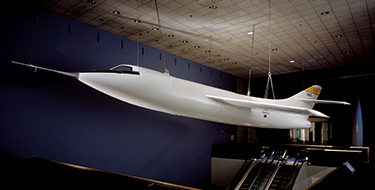
The D-558-II Skyrocket.
Faster than a speeding bullet
Scott Crossfield, ’49, ’50, made aeronautical history on Nov. 20, 1953, when he became the first person to fly at Mach 2, twice the speed of sound (more than 1,320 miles per hour) in the D-558 II Skyrocket. Carried aloft in the supersonic, swept-wing research aircraft by a Boeing Superfortress, he dropped clear of the bomber at 32,000 feet and climbed to 72,000 feet before diving to 62,000 feet, when he broke the world speed record.
Tracking down a bloody killer
Public Health Professor R. Palmer Beasley curtailed the spread of Hepatitis B by advocating the inoculation of newborns after discovering it can be transmitted from the mother to her unborn child, the cause of 95 percent of the world’s Hepatitis B cases. He also proved that Hepatitis B causes the most common form of liver cancer, known as hepatocellular carcinoma. He continues to campaign for universal immunization, since the Hepatitis B vaccine is the only one that prevents a major human cancer.
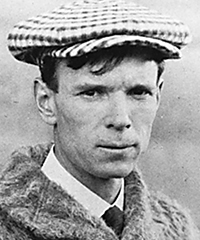
Gilmour Dobie
The ultimate winner
UW Football Coach Gilmour Dobie holds the all-time unbeaten streak in NCAA college football, 61 games (58-0-3, a .975 winning percentage). In addition to never losing a game as the Huskies’ coach, his UW teams outscored opponents 1,930-118. Dobie led the Huskies from 1908 to 1916.
Unstoppable artist
Artist Chuck Close, ’62, continued to paint masterpieces of photorealism after becoming a quadriplegic in 1988 because of a spinal blood clot. Using a paint brush taped to a hand splint, he learned to paint tiny, 2×2 paintings that were later put together to create huge, frontal portraits—and won as much acclaim for his work after his tragedy as before.
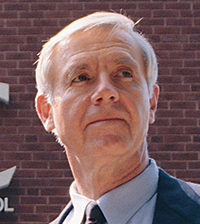
William Foege
Stamping out smallpox
As a medical missionary in Africa in 1966, William Foege, ’61, developed a new technique for vaccinating populations against smallpox. By 1979, his strategy worked to perfection-smallpox vanished from the planet.
They saved Lake Washington
The cleanup of desperately polluted Lake Washington (once known as “Lake Stinko”) was a boon to the environment and a model for scientific and political communities to work together. After the alarm was sounded by Zoology Professor W. Thomas Edmondson, a political movement led by James Ellis, ’48, and others prompted the creation of Metro, a government entity that funded new sewage treatment plants, helped curtail of algae and phosphate concentrations and restored the water quality.
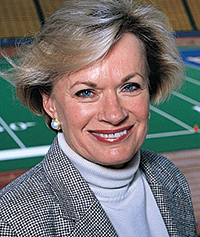
Barbara Hedges
Women’s role model
Athletic Director Barbara Hedges is the longest-serving woman athletic director at an NCAA Division 1-A university. In the 12 years since she joined the UW, Hedges has overseen the UW’s 23 varsity sports, increased the number of women’s sports, upgraded athletic facilities and guided the UW sports programs into the top 15 in the nation.
Imprisoned for his beliefs
When he was a UW senior, Gordon Hirabayashi, ’46, ’49, ’52, purposely broke a World War II curfew imposed on Americans of Japanese descent, setting up a legal challenge to the curfew and forced internment of 120,000 Japanese. He lost that challenge and spent two years in prison. His conviction was overturned in 1986.
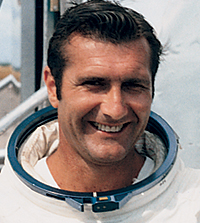
Richard Gordon
Flying to the moon
As an astronaut on Apollo 12, the second manned mission to land on the moon, Richard F. Gordon Jr., ’51, circled the moon while astronauts Alan Bean and Pete Conrad walked on the lunar surface in November 1969.
Saving Native American heritage
Anthropology Professor Melville Jacobs preserved 524 Native American songs—most in languages that are now extinct—by building his own portable phonograph and crossing the Pacific Northwest in his automobile to record tribal songs.
Rescuing Apollo 13
A renowned engineer for the Apollo missions to the moon, George W. Jeffs, ’45, ’48, was part of the team that raced the clock to save the crippled Apollo 13 spacecraft, which had suffered a catastrophic explosion 220 miles from Earth. His development of real-time management with computers allowed scientists to make split-second decisions. The rescue team won a Presidential Medal of Freedom.
From the Holocaust to Congress
Rep. Tom Lantos, ’49, ’50, is a Hungarian-born Jew who survived Nazi death camps to become the only Holocaust survivor elected to the U.S. Congress. He was penniless when he arrived in Seattle after the war to study at the UW, but eventually earned a Ph.D. at California and was elected to Congress in 1980. He has been one of this nation’s greatest human rights advocates for the past two decades.

Warren Moon
The man with the golden arm
Quarterback Warren Moon, ’78, threw for more yards (70,553) than anyone else in the history of professional football. This includes 49,325 yards in a 17-year NFL career and 21,228 yards in six years in the CFL.
Escaped Nazis to become genetics pioneer
Medicine and Genome Sciences Professor Arno Motulsky survived Nazi persecution and prisoner of war camps to make a desperate escape to America. After becoming a doctor, he joined the UW medical school and founded its division of medical genetics-one of the first in the country and crucial to the eventual decoding of the human genome.
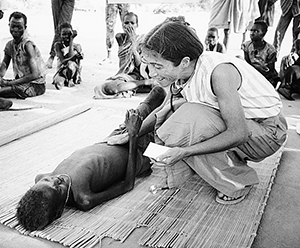
Jill Seaman
Eradicating disease in Africa
Physician Jill Seaman, ’79, fought a parasitic disease in war-torn Sudan, helping curb an epidemic that had killed more than 100,000 people. She has gone from village to village, helping treat tuberculosis, kala-azar and sleeping sickness in areas just south of the western Upper Nile, where infection rates top 20 percent.
Stunning Olympic victory
After meeting for the first time at the U.S. Olympic Trials, the 1936 Washington Varsity Crew overcame inexperience—and assignment to the worst possible lane—to come from behind and win the Olympic gold medal for eight-man crew.
Setting the standard for women’s crew
The Washington Women’s Crew team has won more NCAA titles than any other women’s crew (1997, 1998 and 2001) since the NCAA instituted a national women’s crew championship.

Pike Place Market
Saved Pike Place Market
Architecture Professor Victor Steinbrueck, ’35, saved Pike Place Market from the wrecking ball when the city of Seattle wanted to tear it down to provide a high-rise complex with residential, commercial and hotel facilities. His successful ballot initiative in 1971 created a historic district around the market; today it is a must-see site for any visitor.
Designing the world’s tallest buildings
Architect Minoru Yamasaki, ’34, designed the 110-story World Trade Center towers in New York City. Everything about them was record-breaking: 43,000 windows, 99 elevators, 1,350 feet tall. Credit goes to Yamasaki and structural engineer Leslie E. Robinson for the strength of their design, which prevented the towers from collapsing immediately after the Sept. 11 terrorist attacks, sparing the lives of thousands.
6 UW inventions that changed our world

Doppler ultrasound prototype
Doppler ultrasound
Don Baker, ’60, an electrical engineer, devised the idea of using pulsed Doppler ultrasound in the early days of cardiovascular research. His creation turned ultrasound into the most vital, cost-effective diagnostic tool in the world today.
Long-term dialysis
Belding Scribner, a UW medicine professor, came up with the idea of implanting a Teflon shunt in patients with kidney failure. This allowed repeated, long-term use of dialysis machines that clean the blood, extending the lives of kidney patients significantly. Engineering Professor Albert Babb then helped invent a home dialysis machine. (For more on Dr. Scribner, see “Insomnia, Teflon and Life Savers”, September 1996.)
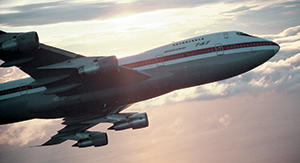
A Boeing 747
Boeing jet airliner
If you have ever traveled on a Boeing commercial airliner, then you are familiar with the work of Maynard Pennell, ’31; Jack Steiner, ’40; Joe Sutter, ’43; John Roundhill, ’67; and others – they were all graduates of the UW’s aeronautical engineering department who were chief designers of jet planes that revolutionized air travel.
Hepatitis B vaccine
Considered one of biotechnology’s greatest triumphs, the vaccine for Hepatitis B was the result of basic research. By working with DNA and yeast cells, Genetics Professor Ben Hall and his team was able to genetically engineer protein production. This technique is used to manufacture to Hepatitis B vaccine. The technology Hall developed was licensed on the UW’s behalf to 16 biotechnical and pharmaceutical firms.
Synthetic rubber
UW chemical engineering alumnus Waldo Semon, ’20, ’24, played a vital role in World War II, when he developed Ameripol, a form of synthetic rubber. He also helped create Government Rubber-Styrene, a synthetic blend of rubber that was essential to the Allied war effort in World War II.
Vinyl
A chemical engineer at B.F. Goodrich, Waldo Semon, ’20, ’24, converted polyvinyl chloride from a hard, unworkable substance into a pliable one-vinyl-that is used in hundreds of products (credit cards, wall coverings, food wrap, plastic bottles, records, garden hoses, etc.) and accounts for a $20 billion industry.
None but the finest: A selection of UW award winners
We could easily run a list of 101 award winners and not even list inventions, great feats or special achievements-but that approach would fail to represent the full breadth of UW accomplishments. So we decided to limit awards, but found that making the cut was one of our greatest challenges. Sadly, we had to drop awards that were specific to one discipline-such as the Lasker Prize in medicine or the Bancroft Prize in history-and focus on programs that cross several disciplines and that are national or international in scope. In addition to famous awards such as the Nobel and Pulitzer prizes, we also included honors given by the White House and Congress for extraordinary lifetime achievements. Yet another awards program, the MacArthur Foundation “genius” grants, not only spans many disciplines, but often highlights unusual achievements.
Nobel Prize
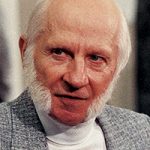
Hans Dehmelt
Hans Dehmelt
The first UW faculty member to win a Nobel Prize, Physics Professor Hans Dehmelt was honored for trapping a single electron as well as for isolating a single atom and watching it make quantum leaps. He shared the 1989 prize in physics.
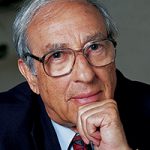
Edmund Fischer
Edmond Fischer
With Edwin Krebs, Biochemistry Professor Edmond Fischer’s research fostered techniques that prevent the body from rejecting transplanted organs. Their breakthrough also opened new doors for research into cancer, blood pressure, inflammatory reactions and brain signals. They shared the 1992 prize in medicine.
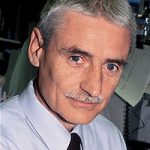
Leland Hartwell
Leland Hartwell
The president and director of the Fred Hutchinson Cancer Research Center, Genome Sciences Professor Leland Hartwell’s basic research on cell division could lead to new therapies to combat cancer. He shared the 2001 prize in medicine.
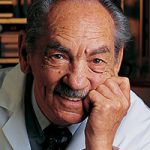
George Hitchings
George Hitchings, ’27, ’28
A scientist for Burroughs Wellcome, George Hitchings’ research was the basis for the development of drugs against a variety of disorders including leukemia, malaria, virus infections and gout. He shared the
1982 prize in medicine.
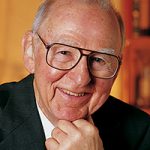
Edwin Krebs
Edwin G. Krebs
Pharmacology/Biochemistry Professor Edwin Krebs and Edmond H. Fischer were the first to turn on certain chemical switches to activate proteins and regulate various cellular processes. Their discovery was a key to unlocking how glycogen in the body breaks down into glucose. They shared the 1992 prize in medicine.
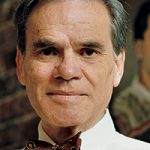
Martin Rodbell
Martin Rodbell, ’54
An NIH scientist, Rodbell discovered how some biochemicals help cells respond to hormones. Aberrations can lead to diseases such as cholera and even some kinds of cancer. He shared the 1994 prize in medicine.
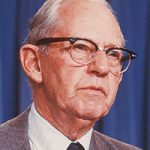
George Stigler
George Stigler, ’31
University of Chicago Economics Professor George Stigler made fundamental contributions to the study of government regulation and market forces, opening up a completely new area of economic research. He won the 1982 prize in economics.
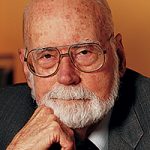
Donnall Thomas
Donnall Thomas
UW Medicine Professor E. Donnall Thomas, who is also a director at the Fred Hutchinson Cancer Research Center, was the first to show that bone marrow could be safely infused into a human patient. He was also the first to treat acute leukemia patients with marrow transplants. He shared the 1990 prize in medicine.
Pulitzer Prize
William Bolcom, ’58
He won the 1988 prize in music for his composition “12 New Etudes for Piano.”
James Wright, ’54, ’59
A student of Theodore Roethke, James Wright won the 1972 Pulitzer Prize in poetry for his Collected Poems.
Robert Cahn, ’38
A Christian Science Monitor reporter, he won a 1969 prize in national reporting for his series on the future of U.S. national parks and how to preserve them.
Ed Guthman, ’41, ’44
This Seattle Times reporter won a 1950 prize in national reporting for his work exonerating UW Professor Melvin Rader, who had been accused of attending a Communist training school.
David Horsey, ’75
This former Daily editor won the 1999 prize in editorial cartooning for his work at the Seattle Post-Intelligencer.
Mike Luckovich, ’82
A former Daily staffer, he won the 1995 prize in editorial cartooning for his work at the Atlanta Constitution.
Eric Nalder, ’68
The only UW alumnus to win two Pulitzers, this former Seattle Times reporter’s first came in 1990 in national reporting for co-writing the coverage on the Exxon Valdez oil spill in Alaska. The second for investigative reporting came in 1997 for a series he co-wrote on corruption in a federal housing program for Native Americans.
Vernon Louis Parrington
The UW historian won the 1928 prize in history for his work Main Currents in American Thought.
Peter Rinearson
A Seattle Times reporter, he won the 1984 prize in feature writing for his account of the new Boeing 757 jetliner, “Making It Fly.” He attended the UW in the 1970s.
Theodore H. Roethke
This legendary UW English professor won the 1954 prize in poetry for his work, The Waking.
National Medal of Arts
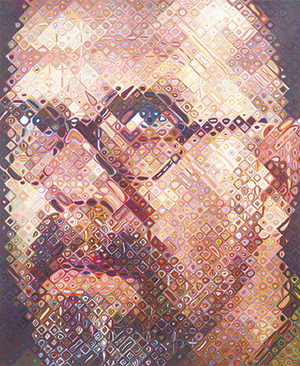
Chuck Close, self-portrait
Chuck Close, ’62
A pioneer in photorealism, artist Chuck Close received a 2000 medal from President Bill Clinton.
Jacob Lawrence
UW Art Professor Jacob Lawrence received a 1990 medal from President George H.W. Bush for his lifetime achievements in painting the African American experience.
Medal of Honor
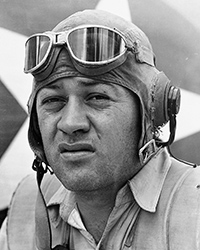
Gregory “Pappy” Boyington
Gregory “Pappy” Boyington, ’34
The Marines’ WWII ace, Boyington downed 28 enemy planes before being captured by the Japanese and spending the rest of the conflict in a prisoner of war camp. His squadron’s exploits became the 1970s TV series, Baa Baa Black Sheep. (For more on “Pappy” Boyington, see “Our Back Pages,” December 1998.)
Deming Bronson, ’15
This UW graduate won a Medal of Honor in World War I for capturing enemy prisoners near Eclisfontaine, France, in1918. He was wounded by a hand grenade and a bullet and still led his unit to capture enemy positions. At the UW, he was a forestry major and played Husky football from 1912-1916 under legendary Coach Gil Dobie.
Robert Galer, ’40
As a Marine Corps major in August and September of 1942, he repeatedly engaged Japanese aerial forces in combat, “individually shooting down 11 enemy bomber and fighter aircraft over a period of 29 days,” according to the text of his medal citation. Galer was himself shot down four times during his service in World War II and Korea. He retired as a brigadier general in 1957.
John D. “Bud” Hawk, ’52
Army Sgt. Hawk was wounded on August 20, 1944 in France when the German army was trying to escape its encirclement following the Normandy invasion. A portion of his medal citation reads, “Sgt. Hawk’s fearless initiative and heroic conduct, even while suffering from a painful wound, was in large measure responsible for crushing two desperate attempts of the enemy to escape from the Falaise Pocket and for taking more than 500 prisoners.”
Robert Leisy, ’68
He served as a 2nd Lt. in the Vietnam War and was awarded the Medal of Honor posthumously. During an engagement in Phuoc Long Province, Leisy’s unit was ambushed by a far larger force of North Vietnamese soldiers. He shielded his men from rocket grenade attack and died of the wounds on Dec. 2, 1969. He was 24.
William Nakamura
Forced to leave the UW because he of the internment of Japanese Americans, William Nakamura enlisted in the famous 442nd Regiment Combat Team, the most decorated military unit in U.S. history. He died in Italy on the Fourth of July, 1944, while providing cover for his pinned-down platoon. He attended the UW in the 1940s.
For more information, see “Final Honors.”
National Medal of Science
Ray Clough, ’42
This University of California engineering professor received a 1994 medal from President Bill Clinton for his contributions to the field of earthquake engineering.
Ernest Davidson
The newly arrived UW chemistry professor received a 2001 medal from President George W. Bush for his contributions to computational quantum chemistry.
Hans Dehmelt
This UW physics professor received a 1995 medal from President Bill Clinton for his pioneering achievements in perfecting electromagnetic traps for single ions, electrons and positrons.
Richard Karp
Karp was on the UW faculty when he received a 1996 medal from President Bill Clinton for his research in theoretical computer science. He has since left the UW for the University of California, Berkeley.
George Stigler, ’31
The University of Chicago economics professor received a 1987 medal from President Ronald Reagan for his efforts to advance the understanding of industry and its relation to government.
Donnall Thomas
This UW medicine professor and Fred Hutchinson Cancer Research Center director received a 1990 medal from President George H.W. Bush for his pioneering work in bone marrow transplants.
National Medal of Technology
George Kozmetsky, ‘38
This high-tech entrepreneur received a 1993 medal from President Bill Clinton “for his commercialization of various technologies” which now “employ tens of thousands of people and export over one billion dollars worldwide.”
Joseph Sutter, ’43
President Ronald Reagan presented this Boeing engineer with a 1985 medal for his “contributions to the development and introduction of generations of jet-powered commercial aircraft, making the U.S. “the predominant supplier of passenger transport aircraft.”
MacArthur Foundation Fellows
Often called “genius” grants, the MacArthur Foundation awards from $250,000 to $500,000 over five years with no strings attached. No one can apply for these fellowships; an anonymous group of 100 “talent scouts” sends names to a secret committee, which makes the final selection. Here are current faculty and alumni who are winners.
Linda Bierds, ’69, ’71
The former head of the UW’s creative writing program, English Professor Linda Bierds is a poet known for her attention to detail and lyrical narratives. She received a PEN/West prize for poetry for her most recent work, The Profile Makers. Fellowship awarded in 1998.
Thomas Daniel
Zoology Professor Thomas Daniel’s research focuses on the basic principles of movement and morphology in animals, everything from the physics of animal swimming and flight to the mechanical properties of muscle. Fellowship awarded in 1996.
Michael Dickinson, ’89
This Cal Tech professor of bioengineering/biology studies the physiology and mechanics of flight behavior in insects-focusing on the flight control system of flies. Fellowship awarded in 2001.
Victoria Foe
A zoology research professor, Victoria Foe’s embryology work explores how living creatures develop from a single, undifferentiated cell. Fellowship awarded in 1993.
Charles Johnson
A novelist, short story writer, essayist, cartoonist and screenwriter, English Professor Charles Johnson won a 1990 National Book Award for his slave trade tale, Middle Passage. Fellowship awarded in 1998.
Richard Kenney
An accomplished poet, English Professor Richard Kenney’s work includes The Invention of the Zero and The Evolution of the Flightless Bird and has appeared in The New Yorker and Atlantic Monthly. Fellowship awarded in 1987.
Rebecca Nelson, ’88
A plant pathology professor at Cornell, Rebecca Nelson studies the genetic background to disease resistance in crops crucial to developing nations such as rice, millet and cassava. Fellowship awarded in 1998.
John Toews
A specialist on modern Europe history, History Professor John Toews recently edited a new edition of The Communist Manifesto. He has been chair of the UW’s Comparative History of Ideas Program since 1982. Fellowship awarded in 1984.
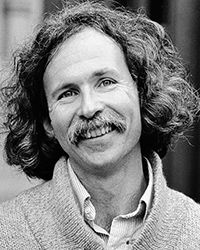
Richard White
Richard White, ’72
Once a UW professor and now at Stanford, Richard White has rewritten the conventional history of the American West in such books as It’s Your Misfortune and None of My Own: A New History of the American West. Fellowship awarded in 1995.
UW inventions and discoveries
During your morning routine, you might turn on your color TV to catch the latest news, start up your personal computer’s operating system to check e-mail, spend 20 minutes jogging on your electronic treadmill and brush your teeth with a sonic toothbrush. In the first hour of your day, you’ve already used four inventions created by UW alumni and faculty. Here’s our list of significant UW inventions and discoveries that have had an impact on our lives.
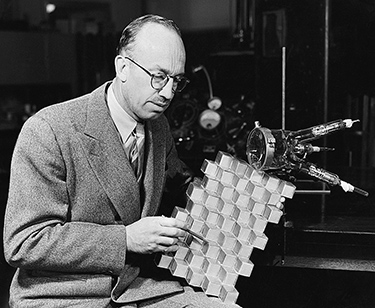
Willard Geer
Color TV tube
The process that brought us color television-three beams of electrons (one for each primary color) fired on a screen of small, inverted pyramids, was invented by Willard Geer, a 1927 physics graduate of the UW.
PC operating systems
Before there was MS-DOS, there was CP/M and QDOS. CP/M is recognized as the first practical operating system for personal computers, written by Gary Kildall, ’67, ’72. Then there is QDOS, written by Tim Paterson, ’78, when he was a repair technician for Seattle Computer Products. That company sold QDOS to Microsoft for $50,000. Bill Gates and Paul Allen renamed it MS-DOS, convinced IBM to use it as the operating system for its first personal computers, and built the Microsoft empire on what became the industry standard.
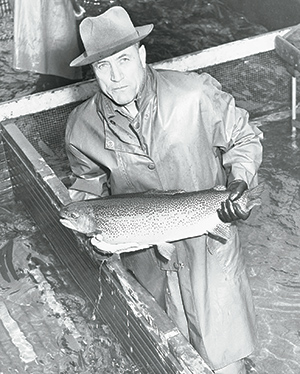
Lauren Donaldson
Donaldson trout and salmon
Using selective breeding and nutrition programs, Fisheries Professor Lauren Donaldson, ‘31, developed a “super trout” that matured twice as fast, weighed 10 pounds and produced many more eggs than normal fish. He also created a completely artificial salmon run and spawning ground at the UW on Portage Bay—the first salmon hatchery in an urban setting.
Ceramic tiles for the space shuttle
With the tiles on the early space shuttles failing in the 2000-plus-degree heat during re-entry, Engineering Professors James Mueller and John Bollard, along with other UW scientists and students, devised solutions to fix the problem: strengthening the tile material itself and toughening the base of the tile to provide stronger load paths from the tile bottom surface to the surface of the vehicle.
Fetal alcohol syndrome
UW Professors David Smith and Ann Streissguth and student Kenneth Jones published the first definition of fetal alcohol syndrome and its characteristic physical and behavior features. They also created new screening methods for the condition.
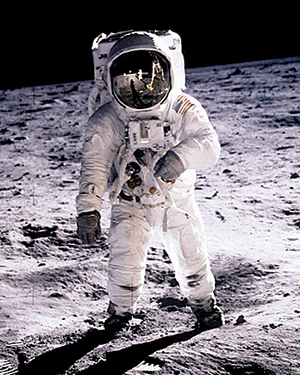
Astronaut Edwin Aldrin wears a “hard” spacesuit during the historic 1969 landing on the moon. Photo courtesy NASA.
Hard spacesuit
An electrical engineer, alumnus Siegfried Hansen, ‘33, came up with the hard spacesuit NASA has used in space missions. He is called the father of E.V.A. (extravehicular activity).
Pacific oyster industry
UW Professor Treavor Kincaid, Class of 1899, established the Pacific oyster industry and years later UW Fisheries Professor Kenneth Chew developed the triploid oyster, which doesn’t become soft and mushy during summer spawning season. These oysters are larger than normal and can be marketed all year long.
Mark 9 Torpedo Exploder
Working with the U.S. Navy to come up with a more reliable exploder for torpedoes, UW Physicist Joe Henderson created the Mark 9 Torpedo Exploder in 1945, a significant improvement that would only detonate when it was under the keel of the target ship.
Medic One emergency services
UW Cardiology Professor Leonard Cobb and other researchers believed lives could be saved with major intervention outside of the hospital and that non-physicians could provide high-quality care under the remote guidance of physicians. The result was the model for emergency care services throughout the world and CPR training for millions.
Rotablator
Professor David Auth invented this device, which uses a tiny catheter for inserting into an artery to clean out a blockage. It has a football-shaped burr at the end, rotating at speeds up to 190,000 rpm. Like a tiny sander, it removes the brittle plaque material while leaving healthy tissue intact.
Shareware
PC-WRITE, written by Bob Wallace, ’78, was the first software program distributed for free with a proviso asking for a contribution. If the user sent back the fee, he or she would receive added features. Wallace dubbed the idea “shareware,” a concept that has spread worldwide with the birth of the Internet.
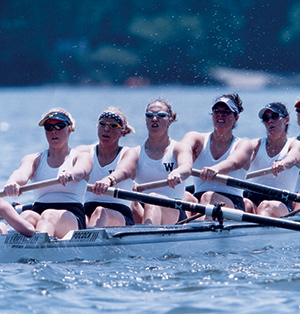
Husky women’s crew race in a Pocock shell.
Pocock rowing shell
A British boat builder and crew racer, George Pocock came to the U.S. and built floatplane pontoons for Boeing. He returned to his first love, boat building, when he joined the UW and built the shell that the then-unknown UW crew team used to win a national championship.
Seattle Foot
UW orthopedic surgeon Ernest M. Burgess and his colleagues developed the Seattle Foot, a specially engineered prosthesis that allows lower limb amputees to run and engage in active movements. It is worn by more than 120,000 amputees worldwide and received a Presidential Design Achievement Award (1974) and the Washington Governor’s Award for New Products (1990).
Sonicare toothbrush
UW researchers David Engel, Joseph Miller and Roy Martin helped entrepreneur David Giuliani make the first sonic toothbrush, whose bristle tips move 100 times faster than you can brush manually. The cleaning action also directs fluids deep between teeth and below the gumline to remove plaque and prevent gum disease.
Talking book
Blind alumnus Robert Irwin, 1906, was the force behind the creation of the “talking book,” which allowed the visually impaired to “read” a book by playing records of spoken text.
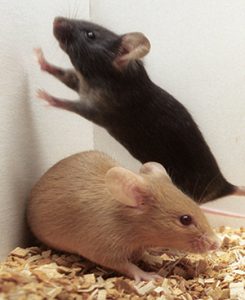
Transgenic mice
Transgenic mice
By transferring a gene from one mouse embryo to another in such a way that the gene would be inherited in its future offspring, UW biochemist Richard Palmiter created a new tool to investigate disorders caused by errors in the genetic code.
Treadmills and the Bruce Protocol
UW cardiologist Robert A. Bruce, called the father of exercise cardiology, developed the standard treadmill test to diagnose and evaluate heart and lung disease, using the first medical treadmills, designed by UW staffer Wayne Quinton. It is used worldwide and was a huge improvement over the previous step test, which was too strenuous. Such conditions as angina pectoris, a previous heart attack or a ventricular aneurysm could be detected with the new creation.
American culture will never be the same
Disposable diaper
Victor Mills, ’26, a chemical engineer working for Procter & Gamble, was given a challenge when the consumer products giant purchased a pulp mill and told him to see what he could make of it. He invented the disposable diaper, a revolutionary development that today is a $3 billion industry.
I-formation
Don Coryell, ’50, ’51, a former Husky defensive back, is credited with inventing the “I” formation in football, an offensive scheme where two running backs line up directly behind the quarterback. That not only bolsters the running game but allows five players to be eligible to receive passes.
Rabbit ears antenna
As a design engineer for General Electric, Karsten Solheim, ’33, invented the rabbit ears antenna-the first portable antenna for TV reception.
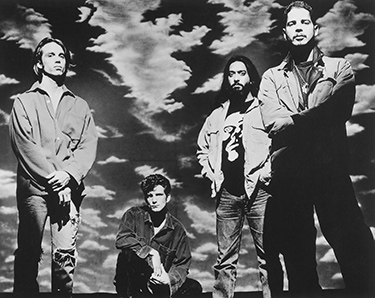
Soundgarden
Grunge rock
No one person invented it, but without the contributions of former UW students, it may never have become an international phenomenon. Some of the band members in seminal groups such as Soundgarden, Mudhoney and Pearl Jam were UW students. The co-founder of Subpop Records-which signed Nirvana and other supergroups to their first recording contracts-was a UW student, and student radio station KCMU popularized the sound long before it dominated the airwaves and MTV.
Synthetic bubble gum
Though more famous for creating vinyl and synthetic rubber, this was the invention alumnus Waldo Semon took most pleasure in. Synthetic rubber bubble gum looked like ordinary gum but could blow great big bubbles. However, B.F. Goodrich, Semon’s employer, thought it was a defect and that nobody would buy it.
The Wave
Robb Weller, ’72, a former UW yell leader, and Bill Bissell, the Husky Marching Band director, came up with the idea for the Wave in 1981, and it caught on as a staple in sports stadiums nationwide.
Institutional achievements recognized by national organizations
No. 1 in research
The University of Washington receives more funding from federal research grants than any other public university in the nation—and has been number one among publics since 1975. Since these grants are awarded on a competitive basis through peer review, it is a reflection of the outstanding quality of UW faculty.
Top-ranked nursing and medical schools
In its rankings of U.S. universities, U.S. News and World Report has named the School of Nursing the top program for seven years in a row and the primary care program in the School of Medicine the number one program for nine years in a row. In its most recent rankings, it also listed the Family Medicine program and the Rural Medicine program as best in the nation.
National achievement in graduate programs
Once every 10 years the National Research Council ranks graduate-level programs at research universities. Within higher education, these are the most significant assessments of programs on a national scale. In the most recent rankings, nearly one-third of UW Ph.D. programs were in the top 10 nationally and almost three-fourths were in the top 25.
Public service through the Peace Corps
The University of Washington provides more Peace Corps volunteers than any other college or university in the nation except Cal-Berkeley and the University of Wisconsin. The corps estimates that since the program began in 1961, more than 2,160 Huskies have volunteered for international service.
Among the top schools in giving
The UW is among the top four public universities in the nation in attracting private support dollars. In its annual review of philanthropy, the Council for Aid to Education found that only Wisconsin, UCLA and Michigan drew more private support in 1999-2000.
One of the best hospitals in the nation
Out of almost 2,000 hospitals in the nation, UW Medical Center ranked 11th according to U.S. News and World Report.
Most cited math department
The UW Department of Mathematics is the top math department in the nation for the number of times its faculty publications were cited in major academic journals, according to Science Watch magazine. The magazine surveyed the top 100 federally funded universities for faculty articles published between 1993 and 1998.
Sports program stands on its own feet
Out of 115 Division I-A athletic programs, the UW is one of only 17 programs that are not subsidized by state funds or student fees, according to a recent poll of sports information directors. The only other Pac-10 program that is not subsidized is USC—a private university.